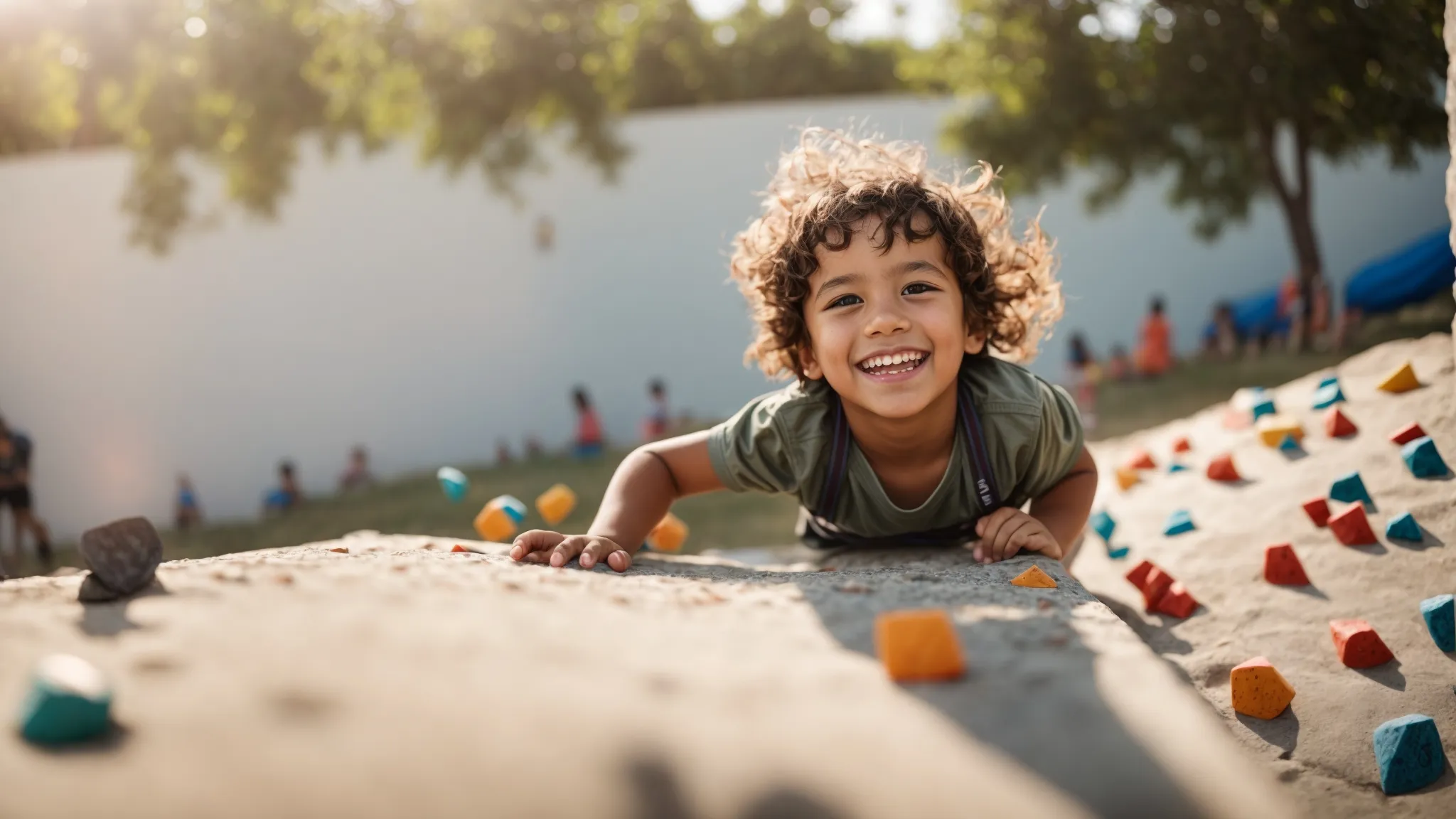In the intricate tapestry of childhood development, self-belief emerges as a golden thread, weaving through the fabric of a child’s life to color their perspective with hues of confidence and resilience.
Parents and caregivers stand as guides, holding the power to nurture this belief, fostering a landscape where children grow to conquer mountains of doubt with the sheer force of their will.
However, like any skill, cultivating a strong sense of self-belief in children requires understanding, patience, and a toolkit brimming with strategies designed to uplift and inspire.
In this article, we unravel the secrets behind bolstering this invaluable attribute in our young ones, offering practical advice and thoughtful insights to guide you through.
Keep reading to embark on this transformative journey together.
Key Takeaways
- Nurturing Self-Belief in Children Fosters Resilience and the Ability to Rebound From Failure.
- Fostering a Growth Mindset Early in Life Teaches Children to Value Effort Over Innate Talent.
- Providing Specific and Authentic Praise Helps Develop a Child’s Confidence and Sense of Self-Worth.
- Role Modeling Resilience and Confidence by Parents Deeply Impacts a Child’s Own Belief in Their Abilities.
- Creating a Supportive and Safe Environment Is Crucial for Children to Explore, Fail, and Learn Without Fear
You can learn more about how Prestige Martial Arts teaches children to believe in themselves and develop a “Yes, I Can!” Attitude in this article: https://prestigemartialartstroy.com/leadership-training-for-kids/
Understanding the Impact of Self-Belief on Childhood Development

In the tapestry of childhood development, self-belief emerges as the golden thread interwoven through the fabric of a child’s journey, offering them the armor they need to face the dragons of doubt and discouragement.
This invisible yet palpable force acts as the wind beneath their wings, propelling them over the turbulent seas of challenges and into the serene harbors of success.
Understanding its significance, this section delves into why cultivating a strong sense of self-belief is indispensable for our young ones.
It is the cornerstone upon which children build the resilience to navigate the labyrinth of obstacles strewn in their path and the foundation that supports their aspirations, enabling them to soar toward their potential.
Through this exploration, parents and caregivers gain insights into the transformative power of self-belief in shaping a child’s ability to conquer adversities and carve their niche in the world, underlining its undeniable influence on their eventual triumphs and achievements.
Why Self-Belief Is Essential for Children
Self-belief is the foundation upon which children construct their identity and direction in life. It’s the bedrock that fosters resilience, enabling them to bounce back from setbacks with greater integrity and resolve:
| Self-Belief Element | Impact on Child |
|---|---|
| Resilience | Enhances ability to recover from failures |
| Direction | Clarifies personal goals and aspirations |
| Identity | Shapes a positive self-view and determination |
This intrinsic belief steels them against the bullies of doubt and fear and lights the way through the dark forests of uncertainty, empowering them to emerge into the sunlight of their fullest potential.
The Role of Self-Belief in Overcoming Challenges
Self-belief arms children with an intangible shield, guarding them against the spears of negativity and criticism that challenges often throw their way. It serves as their internal compass, guiding them through the storms of difficulty to reach the shores of achievement. By believing in their capabilities, they understand that failure is not a pitfall but a stepping stone to greatness, teaching them the resilience to stand up and try again.
This profound sense of confidence ignites a spark of optimism within their hearts, allowing them to view obstacles not as insurmountable walls but as hurdles that can be leaped over with effort and determination. It transforms their outlook, encouraging them to perceive every challenge as an opportunity for growth and learning, thereby paving their path with the stepping stones of courage and perseverance towards the pinnacle of their dreams.
How Self-Belief Influences Future Success
The journey towards future triumphs begins on the stepping stones of self-belief. It equips children with the confidence to boldly pursue their ambitions, transforming the dreamy sketches of their future into vivid portraits of success. By nurturing this potent belief, parents and educators give wings to their aspirations, ensuring that doubts and fears are but mere shadows outpaced by the radiant light of potential and achievement.
A child imbued with a robust sense of self-belief sees the world through the lens of possibility rather than limitation. This mental framework is critical in fostering a mindset that anticipates success and devises strategies to surmount the inevitable obstacles. Therefore, the essence of self-belief is not just a catalyst for immediate academic or social achievements but a cornerstone for constructing a fulfilling and successful life.
As we peel back the layers on the pivotal role of self-belief in shaping our children’s futures, a captivating journey awaits. Let’s embark on the transformative path of nurturing a growth mindset to magnify that belief into a beacon of confidence.
Cultivating a Growth Mindset to Foster Self-Belief

In the heart of every child lies the potential to view challenges not as insurmountable peaks but as hills to be climbed with persistence and grit.
Fostering self-belief in children pivots significantly on cultivating a growth mindset, an empowering perspective that shapes their approach to learning and development.
By introducing this concept early in life, parents lay down the stepping stones that lead towards embracing effort rather than fixating on innate talent.
This approach reshapes how children perceive failure—not as a blockade but as a vital step toward mastery.
Parents help reinforce a positive outlook by praising progress. This enables young minds to understand that every attempt, every challenge, and every bit of feedback is a golden opportunity for growth.
This nurturing journey thus evolves into a robust scaffold that supports the child’s evolving self-belief, painting a future rich with possibilities and devoid of the shadows of self-doubt.
Introducing the Concept of a Growth Mindset to Children
Introducing the concept of a growth mindset to children begins with illustrating the beauty of effort and the value of perseverance. Teachers and parents illuminate the pathway by embodying the principles of growth, becoming living examples of resilience in the face of failure and dedication to continuous improvement. Through their actions and words, they showcase that obstacles are merely steps on the journey to achievement, sculpting a child’s perspective to embrace challenges as catalysts for growth.
Dialogue plays a pivotal role in planting the seeds of a growth mindset in young minds. Caregivers initiate conversations celebrating effort over ease, process over outcome, and learning over perfection. By shifting the focus from fearing failure to learning from it, they empower children to understand that setbacks are not a reflection of their abilities but opportunities for enhancing their skills and expanding their knowledge, laying a solid foundation for a lifetime of resilient self-belief and boundless curiosity.
Encouraging Effort Over Innate Talent
In the splendid odyssey of nurturing self-belief, redirecting the spotlight from innate talent to the elegance of effort emerges as a pivotal strategy. Parents, acting as the architects of their children’s confidence, sculpt an environment where the grit of trying overshadows the allure of natural ability, portraying the pursuit of mastery as a journey adorned with dedication and hard work.
This shift in perspective transforms the child’s inner narrative from one of limitation to one of limitless possibility. It imbues them with the courage to venture into the unknown, armed with the belief that their efforts will forge their path to success, regardless of the stumbles and falls that may lace their journey. Here, in the crucible of effort, the purest form of self-belief is born, vibrant and invincible against the specters of doubt and fear.
Praising Progress to Reinforce a Positive Outlook
Praise, when dispensed like sunlight, nurtures the seeds of optimism in the fertile ground of a child’s psyche. By celebrating each stride towards progress, no matter how small, parents paint the world in hues of possibility for their children, fostering a landscape where every effort is acknowledged and valued.
This validation echoes in their minds, reminding them that their journey is as significant as their destination. It instills profound confidence in their growth journey, encouraging them to embrace every challenge with a heart fortified by believing in their evolving abilities.
Now, let’s shift our focus towards harnessing the transformative energy of positive reinforcement. Imagine igniting the sparks of self-belief with just a few encouraging words.
The Power of Positive Reinforcement in Building Self-Belief

In the garden of a child’s mind, positive reinforcement acts as the sunlight, essential for the growth of a robust sense of self-belief.
Identifying moments ripe for positive reinforcement, customizing encouragement to suit a child’s unique journey, and maintaining the authenticity of praise through moderated acknowledgment are crucial techniques.
Each action, akin to a gardener knowing precisely when and how to water their plants, ensures the development of a healthy, resilient self-concept in children.
This tailored approach encourages not just growth, but flourishing self-confidence, carefully steering clear of the pitfalls of overpraise to preserve the genuine value and impact of encouragement.
Identifying Opportunities for Positive Reinforcement
Identifying opportunities for positive reinforcement hinges on vigilant observation and genuine interaction with a child’s daily endeavors: the monumental achievements and the nuanced efforts. Such moments present a canvas for parents to illustrate their unwavering support and belief in their child’s potential, casting a light on the pathway to self-assurance and resilience.
- Watching a child navigate a complex puzzle with determination, even when the solution seems elusive, offers a prime moment for encouraging their problem-solving spirit.
- Observing a child share a toy or console a friend in distress shines a spotlight on their budding empathy, deserving of sincere commendation.
- Noticing when a child attempts to read aloud, stumbles, yet perseveres underscores the significance of applauding their courage and tenacity.
These scenarios, flourishing in the every day, represent golden opportunities for parents to fortify a child’s self-belief through positive reinforcement. By seizing these moments to praise achievements and the effort and character shown in tackling challenges, parents weave a stronger fabric of confidence and grit within their children.
Tailoring Your Encouragement to Match Your Child’s Needs
Tailoring your encouragement to match your child’s needs translates to recognizing and appreciating the uniqueness of their journey: a parent must be observant and adaptable. With their tapestry of abilities and challenges, each child thrives under a canopy of customized support that echoes their personal aspirations and battles.
- For a child who revels in social interaction, celebrating their efforts in teamwork or communication strengthens their confidence in social settings.
- A young learner grappling with a learning disability benefits immensely from praise acknowledging their perseverance and resourcefulness in overcoming academic hurdles.
- For the introspective soul, highlighted progress in self-expression through writing or art, nurtures their sense of identity and self-worth.
This tailored approach ensures that encouragement is not just a blanket of vague applause but a focused beam of support that elevates a child’s strengths and gently bolsters their areas of development. Such specificity in recognition fosters a deeper sense of self-belief and cultivates a child’s understanding of their value and place within their community.
Avoiding Overpraise to Maintain Authenticity
In the intricate dance of nurturing a child’s self-belief, the melody of praise must be played with discretion to preserve its authenticity. Overpraising, akin to watering a plant too much, can drown its roots, leaving the child unsure of which achievements genuinely warrant recognition and which do not, thus warping their perception of success and self-worth.
Parents must strike a harmonious balance, ensuring that commendation is meaningful and merited. This nuanced approach ensures that children understand the value of their efforts and achievements, reinforcing their confidence in a manner grounded in reality rather than inflated by hollow words. Each word of encouragement becomes a stepping stone for genuine growth, not a pedestal too fragile to support them.
Stepping from the nurturing ground of positive reinforcement, we venture into the realm where resilience and confidence bloom. Join us as we illuminate the path to becoming the beacon of perseverance your children aspire to.
Role Modeling Resilience and Confidence for Your Children

In the orchestra of life, every parent conducts the symphony of resilience and confidence through words and actions.
As children closely observe the comportment of their guardians, parents become the living textbooks from which they learn the art of bouncing back from failure, carrying themselves with confidence, and embracing the lifelong journey of learning.
This intrinsic curriculum, taught by example, equips young minds with the tools to construct their resilience and self-assurance, fostering a robust foundation for navigating the ebbs and flows of their unique paths.
Demonstrating how to recover from setbacks, exuding confidence in one’s abilities, and candidly sharing personal learning experiences with a child embodies the essence of role modeling.
This dynamic process not only cultivates a resilient and confident identity within the child but also seals the bond of understanding and trust that paves the way for their autonomous growth.
Demonstrating How to Bounce Back From Failure
Bouncing back from failure is an art taught most effectively by example. When parents openly discuss their own setbacks and the strategies they employ to overcome them, they provide a tangible framework for resilience and problem-solving. This transparency in acknowledging failure not as a weakness but as a pivotal part of growth ingrains a similar resilience in children, teaching them to view their stumbles through a lens of learning and opportunity.
Parents need to narrate the recovery steps from their life challenges, demonstrating the importance of perseverance and a positive mindset in the face of adversity. By illustrating this journey from setback to success, parents instill a deep-rooted belief in their children that every failure is merely a chapter in the larger story of their life, not the end of it:
- Sharing a personal experience of overcoming a challenge at work, detailing the emotions felt and the lessons learned.
- Describing a time when a goal seemed unreachable but was eventually achieved through persistence and creative problem-solving.
- Discussing a past incident of academic or extracurricular failure and showcasing the steps taken to improve and eventually succeed.
Showing Confidence in Your Abilities
Portraying confidence in one’s capabilities sets a towering beacon of self-assurance for children, guiding them to develop a robust sense of self-belief. When parents exemplify unwavering faith in their skills, whether in completing a task at work with precision or solving a problem at home with creativity, they offer their children a live portrayal of what confidence looks like in practice, not just in theory.
This demonstration of self-confidence by parents in their daily lives, from expressing their opinions during a community meeting to showcasing their talents without hesitation, becomes the canvas upon which children paint their perceptions of self-worth and ability. It teaches them to value their unique strengths and abilities, encouraging them to approach challenges with a poised and confident mindset rooted in the example set forth by their role models.
Sharing Your Learning Experiences With Your Child
Opening the book of life and sharing the chapters of personal learning experiences with a child is akin to planting seeds of wisdom in fertile soil. When parents candidly disclose the hurdles they’ve surmounted and the knowledge gleaned from each, they envelop their child in a cloak of trust and understanding, setting a profound example of lifelong learning and resilience.
This dialogue between parent and child, rich with anecdotes of both triumph and tribulation, fosters a deep-seated belief in the power of persistence and adaptability. It demonstrates that learning is an infinite journey, not confined to the walls of a school but woven into the very fabric of daily existence, empowering children to embrace their educational adventures with zeal and courage.
Embarking on this journey, we’ve explored the bedrock of resilience and confidence. Next up, we dip our toes into the transformative waters of crafting an environment that breathes life into self-belief.
Creating a Supportive Environment That Encourages Self-Belief

In the symphony of nurturing a child’s self-belief, the creation of a supportive environment harmonizes each note of encouragement, emerging as a sanctuary where the seeds of confidence are sown and nurtured to thrive.
This nurturing soil is cultivated through ensuring safe spaces for experimentation, setting goals that walk the fine line between challenge and achievability, and weaving the social threads that bolster a child’s belief in themselves.
Delving into the essence of these practices, parents orchestrate a world where trying new endeavors is celebrated, achievements—no matter how small—are recognized as milestones, and relationships serve as mirrors reflecting the strength and potential within each child.
It’s within this carefully crafted milieu that children learn the dance of resilience, tune their strings of self-confidence, and play the melody of their unique contributions to the world with pride and assurance.
Ensuring a Safe Space for Trying New Things
Creating an environment that promotes the courage to venture into the unknown starts with establishing a safe space for experimentation. Such a nurturing ground allows children to explore novel ideas and pursue interests without the shadow of judgment or the fear of ridicule looming overhead: a place where trying and failing are seen as essential steps in the journey of learning and growth.
| Aspect of Safe Space | Benefits for the Child |
|---|---|
| Freedom to Explore | Encourages curiosity and innovation |
| Acceptance of Failure | Builds resilience and understanding of learning as a process |
| Non-judgmental Support | Strengthens confidence in personal abilities and decisions |
In such an environment, the notion of failure transforms from an end to a means; it becomes a powerful teacher rather than a detractor. This atmosphere of acceptance and support cultivates a mindset where children grasp that every attempt, whether successful or not, enriches their tapestry of experiences, thereby fostering a deeper sense of self-belief and courage to face future challenges.
Setting Realistic Expectations and Celebrating Small Victories
Striking a delicate balance between ambition and attainability cultivates an environment where children feel empowered to reach for the stars while keeping their feet grounded in reality: Parents who craft goals that both inspire and remain within the realm of the possible offer their children a ladder to the sky, each rung a testament to the synergy of dreams and diligence.
| Goal-Setting Aspect | Impact on Child |
|---|---|
| Aspiration | Ignites desire and motivation |
| Attainability | Ensures feelings of success and progress |
| Balanced Goals | Strengthens resilience and self-belief through achievable challenges |
Acknowledging each achievement, no matter its size, reinforces a child’s burgeoning sense of self-worth: Celebratory words and gestures, when aligned with their efforts, act as echoes of affirmation that nurture confidence and pride, crafting a reservoir of self-belief from which they can draw strength in the face of future challenges.
Encouraging Social Connections That Build Confidence
Social connections serve as the unseen scaffold, propping up a child’s burgeoning self-belief with every positive interaction. When a parent nurtures environments where children engage constructively with peers, they provide their offspring a stage to practice empathy, cooperation, and problem-solving. Such interactions, rich with diversity and challenge, are instrumental in instilling confidence through the realization of one’s ability to positively influence and be part of a wider community.
Moreover, these connections act as mirrors reflecting the myriad facets of a child’s personality back at them, allowing for a richer understanding and appreciation of their own identity. Through forging friendships and participating in group activities, children gain affirmation of their worth and abilities, a key ingredient to crafting a resilient and confident demeanor. It is through these social tapestries that children weave the threads of self-belief, learning to trust in their capabilities while appreciating the unique contributions of others.
Having unraveled the essence of weaving a secure net of self-trust, we plunge into the blueprint of everyday actions. Let’s ignite the flame of self-belief with practical, step-by-step strategies that embolden and inspire.
Practical Strategies to Encourage Self-Belief Daily

In the vast landscape of childhood, where every sunrise brings new challenges and opportunities, fostering a strong pillar of self-belief within our children becomes paramount.
By interweaving practical strategies into the fabric of daily life, parents can equip their young ones with the tools necessary to navigate this journey with confidence and resilience.
Implementing daily affirmations, establishing tangible goals and tracking progress, along with teaching problem-solving skills, form the bedrock of nurturing independent thinkers brimming with self-belief.
These methods not only strengthen the roots of confidence but also encourage a mindset adept at overcoming obstacles, setting the stage for a lifetime of achievements and self-assurance.
Implementing Daily Affirmations With Your Child
Embarking on the journey of instilling daily affirmations with your child, parents become the architects laying the first stones of a fortress of self-belief. These verbal reinforcements, when swung like gentle hammers, shape the mental sculpture of a child’s confidence, etching the belief deep into their marrow that they possess the strength, intelligence, and creativity to navigate life’s myriad paths.
Within the sanctuary of home, where words wield the power to build or break, parents utter these affirmations as sacred incantations, breathing life into the fledgling wings of a child’s self-esteem. Such acts of spoken faith act as beacons, guiding young souls through the fog of daily challenges, ensuring that each step is taken with a heart bolstered by the unshakeable belief in their own limitless potential.
Establishing Goals and Tracking Progress Together
In the nurturing journey towards instilling self-belief, the act of setting clearly defined goals with children stands as a foundational pillar. This collaborative process emboldens them to envision their future with clarity and purpose, fostering a sense of agency over their path. As guardians sketch out objectives together with their wards, they are essentially laying down a map that guides their young explorers towards the treasure trove of self-discovery and achievement.
Tracking progress towards these goals transforms an abstract aspiration into a visible, tangible journey of growth. Such a strategy not only celebrates every milestone reached but also provides invaluable lessons in persistence and adaptability. When children and their caregivers regularly review progress, it becomes an empowering ritual that reinforces the child’s belief in their capacities to surmount challenges and edge closer to their dreams, crafting a resilient and self-assured individual.
Teaching Problem-Solving Skills to Foster Independence and Self-Belief
Nurturing the ability to navigate life’s puzzles independently, parents and educators imbue children with the problem-solving skills essential for fostering a steadfast belief in their own decision-making capabilities. This empowerment originates in the deliberate act of guiding children through the process of identifying problems, brainstorming potential solutions, and evaluating the outcomes of their actions, a journey that not only sharpens their cognitive abilities but also cements their confidence in their capacity to overcome future challenges.
By encouraging young minds to embrace the complexities of problem-solving as opportunities for growth rather than insurmountable obstacles, caretakers cultivate an environment where independence blossoms alongside self-belief. This approach transforms the realm of problem-solving from a daunting task into an exciting adventure, inviting children to trust in their intuition and reasoning, thereby fortifying their sense of autonomy and self-assuredness in their journey through life’s twists and turns.
Frequently Asked Questions
How does self-belief impact a child’s overall development?
Self-belief, a vibrant tapestry woven from threads of confidence, optimism, and faith, acts as the cornerstone upon which a child’s universe is built. Much like a tree that stretches its roots deep into the nourishing soil of encouragement and praise, children anchored in self-belief grow with the resilience and grit necessary to face life’s tempests. This is not merely a poetic metaphor but a reflection of a profound truth recognized by experts in child development, including Albert Bandura, who underscores the role of self-efficacy in navigating the complex landscape of growth and learning. Parents, acting as the primary architects of this nurturing environment, alongside teachers and caregivers, serve as the steady rain and sunlight, fostering growth through consistent feedback and the celebration of milestones, however small they might seem.
In the intricate dance of development, the reverberations of self-belief echo through every aspect of a child’s being, from the synaptic connections sparking to life in their brain, to the way they wield a toy with intent and purpose. It shapes their language and coaxes their mind to embrace challenges with optimism rather than fear. A child armed with self-belief approaches a problem not as an insurmountable peak but as a puzzle to be solved, fostering critical thinking and problem-solving skills integral to both academic success and the broader theater of life. This internal compass guides them through the murky waters of bullying, peer pressure, and the myriad challenges that punctuate the journey from preschool through primary school and beyond. What’s more, it lays the foundation for mental health by providing a buffer against anxiety and stress, empowering children to view failure not as a setback but as a stepping stone toward their goals.
Thus, self-belief is not merely a facet of character but a beacon that lights the path to lifelong learning, emotional intelligence, and the resilience necessary to sculpt one’s destiny from the clay of dreams and effort. It whispers of potential amidst the cacophony of doubt, encouraging young minds to soar beyond the confines of circumstance and embrace the limitless sky of possibility. In nurturing this belief, we grant our children the wings to explore, discover, and ultimately thrive in the vast expanse of their own unique experiences.
What are some strategies to cultivate a growth mindset in children?
Nurturing a growth mindset within the fertile minds of children is akin to tenderly planting seeds in rich soil, watching with anticipation as roots of belief in limitless potential dig deep. Far beyond the boundaries of preschool doodles and primary school arithmetic, the cultivation of such a mindset opens the doors to a life where challenges are not roadblocks but stepping stones to mastery. At the heart of this psychological tapestry, we find a blend of patience, praise, and persistence, weaving a narrative that encourages children to embrace the beauty of becoming rather than the stagnation of being.
The melody of encouraging words, “You worked hard on that problem,” replaces the hollow echo of “You’re so smart,” in homes and classrooms alike. This subtle shift in feedback unveils a world where effort outshines innate ability, and improvement is the most coveted trophy. Renowned psychologist Albert Bandura’s concept of self-efficacy whispers through these interactions, suggesting that a child’s belief in their ability to succeed significantly shapes their future. Whether through the pages of a book, the strings of a musical instrument, or the challenge of a new language, every task becomes a canvas for demonstrating that skill development is an ongoing odyssey, not an instant teleportation to expertise.
Moreover, embedding resilience and perseverance within the framework of daily tasks—be it homework, public speaking, or solving a complex puzzle—empowers children with a toolkit for life’s inevitable hurdles. Educators and caregivers morph into role models, embodying the principles of grit and empathy, painting a picture of a future forged by decisions steeped in optimism and motivation. In this orchestra of growth, every note of failure is met with a symphony of strategies for coping, ensuring that stress and anxiety are but transient shadows, outshone by enduring confidence and emotional intelligence. Like a garden where diverse plants bloom under the attentive gaze of a gardener, a community united in this belief system fosters a generation ready to convert every stumble into a step forward, armed with a growth mindset as their compass.
Why is positive reinforcement crucial in building a child’s self-belief?
In the mosaic of child development, positive reinforcement emerges as a glimmering tile whose significance cannot be overstated. It acts as a beacon of encouragement, guiding a child through the murky waters of doubt toward the shores of self-belief. Imagine a scenario where a child, hesitant to present in front of their class, receives not criticism but praise for their bravery to stand up and speak. This moment, akin to a seed being watered, nurtures the fragile bud of confidence in their abilities. It’s a lesson in optimism, wrapped up in the simplicity of acknowledgment. The teacher, or any caregiver in this scenario, becomes a mirror reflecting the potential they see, encouraging the child’s belief in their capabilities. Like rays of sunlight breaking through clouds, positive reinforcement illuminates a child’s mind, allowing the seeds of self-esteem to flourish.
The science behind this is robust, with roots deeply entrenched in the theories posited by psychologists such as Albert Bandura. His concept of self-efficacy, the belief in one’s own ability to succeed, underscores the profound impact of positive reinforcement. Through a lens of empathy, parents and educators can see how repeated encouragement and feedback transform a child’s mindset. Each word of praise, each note of approval, is a brushstroke on the canvas of a child’s psyche, painting a picture of a world where failure is not a reflection of self-worth but a stepping stone towards mastery and resilience. This environment, rich in love, pride, and support, fosters an atmosphere where learning from mistakes becomes a cherished part of the journey rather than a path to avoid. A child’s ability to tackle challenges, from problem-solving in primary school to navigating the complexities of societal expectations, becomes markedly enhanced under the wings of positive reinforcement. It’s not merely a strategy but a foundational element in nurturing a healthy, optimistic approach to life’s array of puzzles and opportunities.
How can parents role model resilience and confidence for their children?
In the unwavering dance of life, parents stand as the enduring role models, the lighthouses in their children’s journey through tempestuous seas. They are the sculptors of resilience and architects of confidence, shaping the tender clay of young minds with each word, action, and response. Within this intricate ballet of guidance, parents wield the mighty tools of empathy and grit, building an edifice of strength that defiance and despair cannot erode. Loving yet firm, the parent’s role is akin to that of a seasoned gardener, nurturing the blooming of resilience through the fertile soil of support, understanding, and patient correction.
Yet, how does one embody such an immense responsibility? The answer lies not in grandiose actions but in the daily tapestry of life’s moments. Conversations woven with threads of optimism, tasks sprinkled with praise and free from the shadow of undue criticism, meals shared with laughter and absent the bite of disdain – these are the silent teachers of resilience. Parents who share stories of their battles, clothed in vulnerability yet shining with the gleam of victory, impart a priceless lesson: failure, far from being a pit of despair, is but a stepping stone on the path to success. Through their own journey, parents cut a path through the dense thicket of doubt and fear, lighting the way with the torch of their experience.
Confidence, that elusive bird, is gently coaxed into the sunlight through the gentle affirmation of abilities and the celebration of effort rather than mere outcomes. Like a mirror, parents reflect back to their children a vision of themselves rich in potential and worthy of every effort. Embracing mistakes as learning opportunities and viewing challenges as avenues to grow, parents, through their own lived example, incubate a sense of self-belief in their children. In doing so, they plant deep within their young ones the seeds of resilience, watered by love, that will grow into mighty trees able to withstand the fiercest storms.
What practical daily strategies can parents implement to encourage self-belief in their children?
Amidst the tapestry of daily life, parents stand as the sculptors of their children’s horizons, chiseling away the excess to reveal the masterpiece within. The journey toward fostering self-belief in children winds through the rugged terrain of failures and the lush meadows of triumphs, guided by the light of parental encouragement and understanding. One beacon of guidance in this intricate endeavor is the power of praise – not the empty accolades for every breath taken, but the genuine acknowledgment of effort, progress, and perseverance. Such praise becomes the mirror reflecting a child’s worth, not just in the oasis of success but also amidst the desert of setbacks.
In the symphony of child development, every note of encouragement plays a vital role; thus, embedding opportunities for autonomy in the daily relics of routine serves as a melody of empowerment. By entrusting children with age-appropriate tasks, from the simplicity of choosing a book for an evening story to the complexity of meal planning, parents weave the threads of responsibility and capability into the fabric of their child’s identity. This practice, embroidered with conversations that highlight the child’s thought process and decision-making, cultivates a garden of confidence where the mindset of “I can” flourishes. Beyond the confines of the home, enrolling children in activities that align with their interests – be it art, sports, or science – allows them to explore and polish their abilities, transforming raw talent into skilled mastery with each stroke of effort.
However, the architect of belief constructs not only through the bricks of encouragement and autonomy but also by modeling resilience and optimism. As children navigate the labyrinth of emotions, observing their caregivers stand firm in the face of adversity plants the seeds of grit and determination in their tender minds. Expressing emotions openly, discussing challenges and strategies for overcoming them weave a tapestry of coping skills and emotional intelligence that blankets the child in security and faith. In essence, the journey to instill self-belief in children is akin to nurturing a garden; it requires patience, love, and the right blend of sunlight and shade – praise and challenge – to witness the blossoming of confident, resilient individuals ready to claim their space in the world.
Conclusion
In conclusion, fostering self-belief in children is critical to their development. It gives them the resilience to face challenges and the confidence to pursue their dreams.
By cultivating a growth mindset, encouraging effort over innate talent, and reinforcing positive behaviors through genuine praise, parents and caregivers lay a solid foundation for a child’s sense of self-worth and potential.
Implementing daily affirmations, setting and tracking realistic goals, and teaching problem-solving skills further equip children with the tools necessary for navigating life’s obstacles with poise and determination.
Creating a supportive environment, modeling resilience and confidence, and nurturing social connections that build self-esteem are crucial strategies.
Fostering self-belief in children is about empowering them to see obstacles as opportunities for growth, ensuring they develop into resilient, confident, and capable individuals ready to contribute positively to the world.

